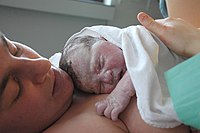
Photo from wikipedia
Context: The pectoralis minor (PM) is an important postural muscle that may benefit from myofascial techniques, such as Graston Technique® (GT) and self-myofascial release (SMR). Objective: To examine the effects… Click to show full abstract
Context: The pectoralis minor (PM) is an important postural muscle that may benefit from myofascial techniques, such as Graston Technique® (GT) and self-myofascial release (SMR). Objective: To examine the effects of GT and SMR on PM length, glenohumeral total arc of motion (TAM), and skin temperature. Design: Cohort. Setting: Laboratory. Participants: Twenty-six healthy participants (19 females and 7 males; age = 20.9 [2.24] y, height = 170.52 [8.66] cm, and weight = 72.45 [12.32] kg) with PM length restriction participated. Interventions: Participants were randomized to the intervention groups (GT = 12 and SMR = 14). GT and SMR interventions were both applied for a total of 5 minutes during each of the 3 treatment sessions. Main Outcome Measures: PM length, TAM, and skin temperature were collected before and after each intervention session (Pre1, Post1, Pre2, Post2, Pre3, and Post3) and at 1-week follow-up (follow-up). Separate intervention by time analyses of variance examined differences for each outcomes measure. Bonferroni post hoc analyses were completed when indicated. Significance was set a priori at P ≤ .05. Results: No significant intervention by time interactions were identified for PM length, TAM, or temperature (P > .05). No significant intervention main effects were identified for PM length (P > .05), TAM (P > .05), or temperature (P > .05) between the GT or SMR technique groups. Overall, time main effects were found for PM length (P = .02) and temperature (P < .001). Post hoc analysis showed a significant increase in PM length for both intervention groups at follow-up (P = .03) compared with Post2. Furthermore, there were significant increases in temperature at Post1 (P < .001), Post2 (P = .01), and Post3 (P < .001) compared with Pre1; Post2 was increased compared with Pre2 (P = .003), Pre3 (P < .001), and follow-up (P = .01); Post3 increased compared with Pre3 (P = .01) and follow-up (P = .01). Conclusion: Serial application of GT and SMR to the PM did not result in increases in PM length or TAM. Regardless of intervention, skin temperature increased following each intervention.
Journal Title: Journal of sport rehabilitation
Year Published: 2019
Link to full text (if available)
Share on Social Media: Sign Up to like & get
recommendations!